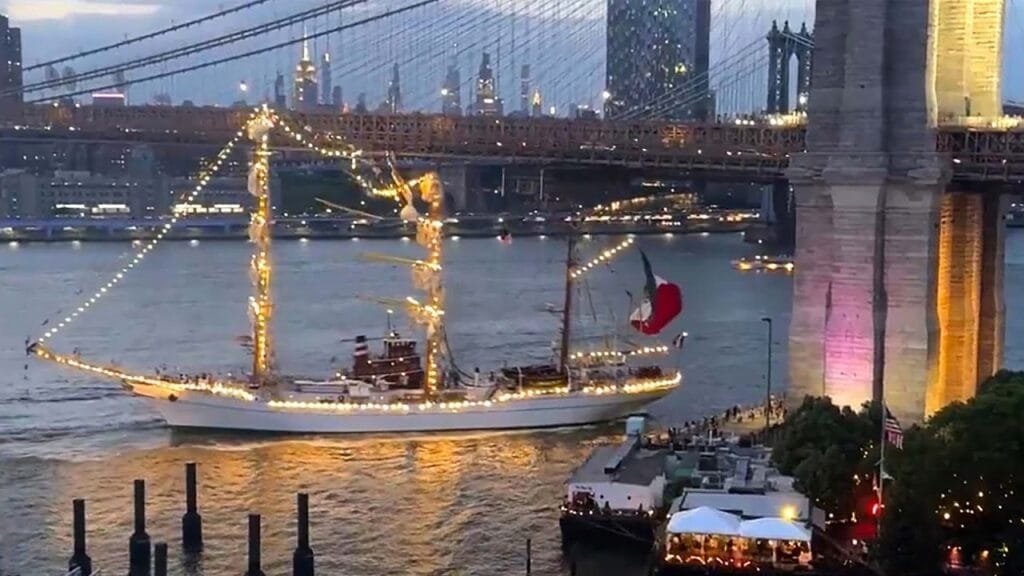Mexico City, Mexico — The Mexican Navy confirmed the deaths of two cadets, América Yamileth Sánchez from Xalapa, Veracruz, and Adal Jair Marcos from Salina Cruz, Oaxaca, following the collision of the training vessel Buque Escuela Cuauhtémoc with New York’s Brooklyn Bridge. The tragic incident occurred on the night of Saturday, May 17, during the ship’s voyage to Iceland.
The Collision and Immediate Aftermath
The Buque Escuela Cuauhtémoc, renowned as the “Ambassador and Gentleman of the Seas,” had been docked at Pier 17 in Manhattan since May 13 as part of a global goodwill tour, welcoming visitors at the South Street Seaport.
The vessel began its departure at approximately 8:20 p.m., backed by a tugboat and cheered by onlookers. The ship initially moved slowly, its rigging lit with white lights and cadets standing aloft on the yards—horizontal spars that support the sails.
But just minutes into the maneuver, the Cuauhtémoc detached from the tugboat and began to pick up speed in reverse, moving directly toward the Brooklyn Bridge. At 8:24 p.m., four minutes after departing, a radio call went out requesting help from any additional tugboats in the area. It remains unclear whether the call came from the ship itself, the assisting tug, or harbor officials.
Forty-five seconds later, at approximately 8:26 p.m., the Cuauhtémoc struck the historic bridge at nearly 7 mph (6 knots). The impact caused all three of its 147-foot masts to snap, sending cadets dangling by their harnesses as the upper rigging collapsed. The ship continued moving in reverse, passing beneath the bridge and striking a pier before finally coming to a stop around 8:27 p.m.
Footage captured by witnesses shows the ship grinding beneath the 142-year-old span. The tugboat, seen racing to overtake the vessel, was unable to intervene in time.
The collision resulted in the deaths of two cadets and injuries to at least 22 others, including two in critical condition. The Brooklyn Bridge itself sustained only minimal structural damage and was quickly reopened to traffic following inspection.
Official Response and Investigation
Secretary of the Navy Admiral Raymundo Pedro Morales issued a statement expressing condolences to the families and affirming an ongoing investigation.
“The investigations to determine the causes of the incident are advancing with transparency and responsibility. The safety of our naval personnel is and always will be a priority for the Secretariat of the Navy. We will spare no effort to clarify this painful event and provide all necessary support to the families of our cadets América and Adal.”
— Admiral Raymundo Pedro Morales, Secretary of the Navy
The National Transportation Safety Board (NTSB) has initiated an investigation into the incident, focusing on potential mechanical failures, the ship’s control systems, and the role of the assisting tugboat. Preliminary findings suggest that the vessel may have experienced an engine malfunction, causing it to move uncontrollably in reverse. Investigators are also examining environmental factors such as wind and current conditions at the time of the collision.
The ship, with its main mast towering at 160 feet (50 meters), is far too tall to pass under the Brooklyn Bridge at any tide.

The Lives Lost: América Sánchez and Adal Marcos
América Yamileth Sánchez González
A 20-year-old cadet at the Heroica Escuela Naval Militar, Sánchez was remembered for her discipline and achievements as a competitive swimmer. Colleagues and instructors described her as a dedicated student who represented her state and institution in national competitions. Her mother, Rocío Hernández, described her as “an exemplary daughter” and “a dedicated student” aiming to become a naval engineer. A private ceremony in her honor is scheduled at the Veracruz Naval Academy before her body is returned to her hometown of Xalapa.
Adal Jair Marcos
Hailing from Salina Cruz, Oaxaca, 23-year-old Marcos was celebrated for his adventurous spirit and commitment to naval service. Friends and family recalled his enthusiasm for travel and his aspiration to serve Mexico at sea. He had always dreamt of following in his father’s footsteps to become a sailor, and being on board the Cuauhtémoc had been his greatest wish.
Investigation and Repatriation
Seven officers and 172 cadets returned to Mexico early Monday, arriving at the port of Veracruz, home to the naval academy. Two injured cadets remained in New York in stable condition receiving medical treatment, according to SEMAR.
The exact circumstances leading to the collision remain under scrutiny. The NTSB continues to examine whether turbulent currents or engine malfunction were factors. The agency is also reviewing video footage, weather data, and audio from maritime radio transmissions to piece together a full timeline of the crash.
The Secretariat of the Navy (SEMAR) pledged full transparency in its inquiry. The NTSB is collaborating with Mexican authorities to access the vessel and interview crew members as part of the ongoing investigation.
National Outpouring of Grief
News of the fatalities has sparked widespread mourning in Veracruz and Oaxaca, the cadets’ home states, as well as across Mexico. Social media tributes have honored their service, while the Heroica Escuela Naval Militar mourns the loss of two promising officers. Mexican President Claudia Sheinbaum expressed condolences and support to the victims’ families.
The Cuauhtémoc, a symbol of Mexican maritime diplomacy, has trained generations of naval cadets. This tragedy underscores the risks inherent in naval service.
Discover more from Riviera Maya News & Events
Subscribe to get the latest posts sent to your email.
